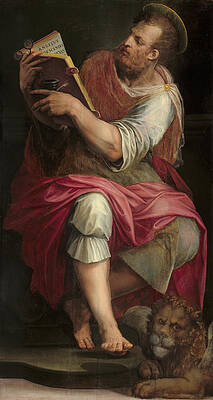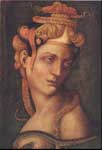Giorgio Vasari
Paintings
The birth of Venus
Six Tuscan Poets
The emperor Massimiliano lifts the siege from Livorno
The storming of the fortress of Stampace in Pisa
The storming of the fortress near Porta Camollia in Siena
Saint Mark
Saint Luke
The Garden of Gethsemane
Allegory of Arezzo
Holy Family with Saint Francis in a Landscape
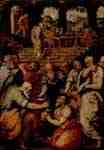
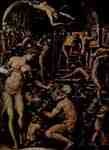
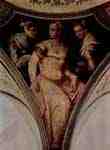
Portrait of Nicolosa Bacci and the noblewoman
Giorgio Vasari (Italian: [ˈdʒordʒo vaˈzaːri]; 30 July 1511 – 27 June 1574) was an Italian painter, architect, writer and historian, most famous today for his Lives of the Most Excellent Painters, Sculptors, and Architects, considered the ideological foundation of art-historical writing.
Early life
Vasari was born in Arezzo, Tuscany.[1] Recommended at an early age by his cousin Luca Signorelli, he became a pupil of Guglielmo da Marsiglia, a skillful painter of stained glass. Sent to Florence at the age of sixteen by Cardinal Silvio Passerini, he joined the circle of Andrea del Sarto and his pupils Rosso Fiorentino and Jacopo Pontormo where his humanist education was encouraged. He was befriended by Michelangelo whose painting style would influence his own.
Painting
Giorgio Vasari, Italian humanists, Tuscan Poets: Dante, Petrarch, Guido Cavalcanti, Boccaccio, Cino da Pistoia and Guittone d'Arezzo[2]
Giorgio Vasari, The Garden of Gethsemane
In 1529, he visited Rome where he studied the works of Raphael and other artists of the Roman High Renaissance. Vasari's own Mannerist paintings were more admired in his lifetime than afterwards. In 1547 he completed the hall of the chancery in Palazzo della Cancelleria in Rome with frescoes that received the name Sala dei Cento Giorni. He was consistently employed by members of the Medici family in Florence and Rome, and worked in Naples, Arezzo and other places. Many of his pictures still exist, the most important being the wall and ceiling paintings in the Sala di Cosimo I in the Palazzo Vecchio in Florence, where he and his assistants were at work from 1555, and the frescoes begun by him inside the vast cupola of the Duomo were completed by Federico Zuccari and with the help of Giovanni Balducci. He also helped to organize the decoration of the Studiolo, now reassembled in the Palazzo Vecchio.
Architecture
Aside from his career as a painter, Vasari was also successful as an architect. His loggia of the Palazzo degli Uffizi by the Arno opens up the vista at the far end of its long narrow courtyard, a unique piece of urban planning that functions as a public piazza, and which, if considered as a short street, is unique as a Renaissance street with a unified architectural treatment. The view of the Loggia from the Arno reveals that, with the Vasari Corridor, it is one of very few structures that line the river which are open to the river itself and appear to embrace the riverside environment.
The Uffizi Loggia.
In Florence, Vasari also built the long passage, now called Vasari Corridor, which connects the Uffizi with the Palazzo Pitti on the other side of the river. The enclosed corridor passes alongside the River Arno on an arcade, crosses the Ponte Vecchio and winds around the exterior of several buildings.
He also renovated the medieval churches of Santa Maria Novella and Santa Croce. At both he removed the original rood screen and loft, and remodelled the retro-choirs in the Mannerist taste of his time. In Santa Croce, he was responsible for the painting of The Adoration of the Magi which was commissioned by Pope Pius V in 1566 and completed in February 1567. It was recently restored, before being put on exhibition in 2011 in Rome and in Naples. Eventually it is planned to return it to the church of Santa Croce in Bosco Marengo (Province of Alessandria, Piedmont).
In 1562 Vasari built the octagonal dome on the Basilica of Our Lady of Humility in Pistoia, an important example of high Renaissance architecture.[3]
In Rome, Vasari worked with Giacomo Barozzi da Vignola and Bartolomeo Ammanati at Pope Julius III's Villa Giulia.
The Lives of the Most Excellent Painters, Sculptors, and Architects
Main article: Lives of the Most Excellent Painters, Sculptors, and Architects
A cover of the Lives
Often called "the first art historian",[4] Vasari invented the genre of the encyclopedia of artistic biographies with his Le Vite de' più eccellenti pittori, scultori, ed architettori (Lives of the Most Eminent Painters, Sculptors, and Architects), dedicated to Grand Duke Cosimo I de' Medici, which was first published in 1550. He was the first to use the term "Renaissance" (rinascita) in print, though an awareness of the ongoing "rebirth" in the arts had been in the air since the time of Alberti, and he was responsible for our use of the term Gothic Art, though he only used the word Goth which he associated with the "barbaric" German style. The Lives also included a novel treatise on the technical methods employed in the arts.[5] The book was partly rewritten and enlarged in 1568, with the addition of woodcut portraits of artists (some conjectural).
The work has a consistent and notorious bias in favour of Florentines and tends to attribute to them all the developments in Renaissance art — for example, the invention of engraving. Venetian art in particular (along with arts from other parts of Europe), is systematically ignored in the first edition. Between the first and second editions, Vasari visited Venice and while the second edition gave more attention to Venetian art (finally including Titian) it did so without achieving a neutral point of view.
Vasari's biographies are interspersed with amusing gossip. Many of his anecdotes have the ring of truth, while others are inventions or generic fictions, such as the tale of young Giotto painting a fly on the surface of a painting by Cimabue that the older master repeatedly tried to brush away, a genre tale that echoes anecdotes told of the Greek painter Apelles. With a few exceptions, however, Vasari's aesthetic judgement was acute and unbiased. He did not research archives for exact dates, as modern art historians do, and naturally his biographies are most dependable for the painters of his own generation and those of the immediate past. Modern criticism – with new materials opened up by research – has corrected many of his traditional dates and attributions.
Vasari includes a sketch of his own biography at the end of the Lives, and adds further details about himself and his family in his lives of Lazzaro Vasari and Francesco Salviati.
According to the historian Richard Goldthwaite,[6] Vasari was one of the earliest authors to use the term "competition" (or "concorrenza" in Italian) in its economic sense. He used it repeatedly, and stressed the concept in his introduction to the life of Pietro Perugino, in explaining the reasons for Florentine artistic preeminence. In Vasari's view, Florentine artists excelled because they were hungry, and they were hungry because their fierce competition amongst themselves for commissions kept them so. Competition, he said, is "one of the nourishments that maintain them."
Social standing
Vasari enjoyed high repute during his lifetime and amassed a considerable fortune. In 1547, he built himself a fine house in Arezzo (now a museum honouring him), and decorated its walls and vaults with paintings. He was elected to the municipal council or priori of his native town, and finally rose to the supreme office of gonfaloniere.
In 1563, he helped found the Florence Accademia e Compagnia delle Arti del Disegno, with the Grand Duke and Michelangelo as capi of the institution and 36 artists chosen as members.
Public collections
Rijksmuseum Amsterdam[7]
See also
The Lives of the Most Excellent Painters, Sculptors, and Architects: Vol. 1, Vol. 2, Vol. 3, Vol. 4, Vol. 5, Vol. 6, Vol. 7, Vol. 8, Vol. 9, Vol. 10. Giorgio Vasari
Reading Vasari, eds. Anne B. Barriault, Andrew T. Ladis, Norman E. Land, and Jeryldene M. Wood (London: Philip Wilson, 2005)
The Ashgate Research Companion to Giorgio Vasari, ed. David J. Cast (Surrey: Ashgate, 2014)
References and sources
The Castration of Uranus: fresco by Vasari & Cristofano Gherardi (c. 1560, Sala di Cosimo I, Palazzo Vecchio, Florence).
References
Gaunt, W. (ed.) (1962) Everyman's dictionary of pictorial art. Volume II. London: Dent, p. 328. ISBN 0-460-03006-X
"Giorgio Vasari Enciclopedia Dantesca". www.treccani.it.
The Christian Travelers Guide to Italy by David Bershad, Carolina Mangone, Irving Hexham 2001 ISBN 0-310-22573-6-page [1]
Vasari, Giorgio. Dictionary of Art Historians, 2013. Retrieved 26 May 2013. Archived here.
Vasari, Giorgio. (1907) Vasari on technique: being the introduction to the three arts of design, architecture, sculpture and painting, prefixed to the Lives of the most excellent painters, sculptors and architects. G. Baldwin Brown Ed. Louisa S. Maclehose Trans. London: Dent.
Richard Goldthwaite, The Economy of Renaissance Florence, 2009, pp. 390.
Collection Rijksmuseum
Sources
The Lives of the Artists Oxford University Press, 1998. ISBN 0-19-283410-X
Lives of the Painters, Sculptors and Architects, Volumes I and II. Everyman's Library, 1996. ISBN 0-679-45101-3
Vasari on Technique. Dover Publications, 1980. ISBN 0-486-20717-X
Life of Michelangelo. Alba House, 2003. ISBN 0-8189-0935-8
Public Domain This article incorporates text from a publication now in the public domain: Chisholm, Hugh, ed. (1911). Encyclopædia Britannica (11th ed.). Cambridge University Press.
---
Fine Art Prints | Greeting Cards | Phone Cases | Lifestyle | Face Masks | Men's , Women' Apparel | Home Decor | jigsaw puzzles | Notebooks | Tapestries | ...
---
Artist
A - B - C - D - E - F - G - H - I - J - K - L - M -
N - O - P - Q - R - S - T - U - V - W - X - Y - Z
Retrieved from "http://en.wikipedia.org/"
All text is available under the terms of the GNU Free Documentation License








